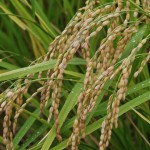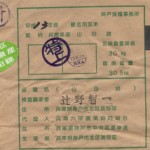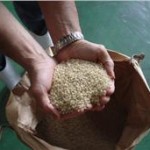 Certainly most readers are aware that rice is not just rice, and that sake rice is better for making sake than regular “table” rice. And surely most readers are also aware that there are various varieties of sake rice, each with its attendant flavors and brewing characteristics. And doubtlessly, most readers know that for lots of reasons, Yamada Nishiki is widely considered the best – even if it is decidedly not the only game in town.
Certainly most readers are aware that rice is not just rice, and that sake rice is better for making sake than regular “table” rice. And surely most readers are also aware that there are various varieties of sake rice, each with its attendant flavors and brewing characteristics. And doubtlessly, most readers know that for lots of reasons, Yamada Nishiki is widely considered the best – even if it is decidedly not the only game in town.
But did you know that not all Yamada Nishiki is created equal, and that there are in fact twenty four different grades of Yamada Nishiki? Well, sort of, anyway…
The “sort of” caveat comes about because not everyone agrees on all aspects of the system that has been set up. On top of that, while there are indeed 24, there is not an absolute hierarchy or order amongst them, as some exist in parallel, and others exist only unofficially.
Let us start with the easy stuff. Rice is usually inspected by the government for quality. The things that are assessed are size, the number of grains with a visible shinpaku (starchy center), the number of cracked grains, the number of undeveloped green grains, and more.
Most rice for eating has three classes, san-to (3rd class), ni-to (2nd class) and itto (1st class). Sake rice has two more on top of that, toku-to (special class) and toku-jo (top special class). Then there is of course the inevitable amount of rice that is not even inspected, for one reason or another. This adds up to a total of six different grades of rice (including not even inspected, that is), and this will apply to any sake rice out there.
 Note, if a sake is not made with an inspected rice, the brewer cannot put a special grade name on the label. In other words, if the rice is not at least inspected then it cannot be sold as a ginjo, a junmai or a honjozo. (Let it suffice to say that this point is a rabbit hole to be saved for another newsletter.)
Note, if a sake is not made with an inspected rice, the brewer cannot put a special grade name on the label. In other words, if the rice is not at least inspected then it cannot be sold as a ginjo, a junmai or a honjozo. (Let it suffice to say that this point is a rabbit hole to be saved for another newsletter.)
So we have six grades for all sake rice, grown anywhere in Japan.
Next, let us focus on Hyogo, the origin of Yamada Nishiki rice. Hyogo is also where it grows best – but note it can be (and is!) grown in many other prefectures as well. Even within Hyogo, there are a few villages nestled next to the mountains that have perfect climactic conditions for growing Yamada Nishiki, and a couple of villages – even a couple of fields – from which the absolute best stuff comes.
Over time, a system of ranking these regions came into existence. It was naturally enough created and driven by the farmers that produce Yamada Nishiki, through the local agricultural cooperative. It was and is also supported at least a bit by the Hyogo Prefectural Government.
In short, the few fields that consistently produce the absolute best Yamada Nishiki are designated at as “Toku A,” (Special A) fields. Those in the immediate vicinity that are almost as good but not quite there are called “A” fields. Others in Hyogo that are not in the area are called “B” fields. And fields growing Yamada outside of Hyogo are doing it in fields called “C” fields.
 Note, though, two things. One, only the top two are commonly used. In fact, I only recently heard of a brewer speak of B and C fields, and know that there are others who do not use that nomenclature at all. It is not law nor obligatory. And two, even the “Special A” and “A” designations are based on agreements amongst the farmers. While they take practical and legal measures to protect and promote this system, it is not the law nor official in any other sense. Also, the fact that the system is recognized at all is proof of the quality of the rice that comes from that region. If the rice were not that good, everyone would just ignore them.
Note, though, two things. One, only the top two are commonly used. In fact, I only recently heard of a brewer speak of B and C fields, and know that there are others who do not use that nomenclature at all. It is not law nor obligatory. And two, even the “Special A” and “A” designations are based on agreements amongst the farmers. While they take practical and legal measures to protect and promote this system, it is not the law nor official in any other sense. Also, the fact that the system is recognized at all is proof of the quality of the rice that comes from that region. If the rice were not that good, everyone would just ignore them.
This ranking of rice paddies is another rabbit hole, albeit it a very interesting one. You can read more about that system, called the “muramaiseido,” here if you like:
http://www.sake-world.com/html/sw-2009_3.html
One more thing to note: while the above ranking of fields is an unofficial system, the inspection of rice is a very official and very regulated system. There are concrete, objective points that are observed and recorded, and they are more or less the same for every inspector everywhere.
So we have four grades of fields, and six grades of rice. That gives a total of 24 possible grades of rice. However, most of them we will just never see.
If the ranking of the field is listed on the label, we only really see “Special A” or “A” on a label. No one will write “B” or “C” for all to see. This is for two reasons: one, no one brags about being second or third, and two, the field designation system is only officially recognized inside the “Yamada Nishiki Club,” (my term!) or those that own and till the best fields. No outside of their considers or calls their fields B, and no one outside considers their fields C fields. “That’s a Hyogo thing,” disdained one brewer north of Tokyo in response to my question about his home-grown Yamada.
Also, many that grow their Yamada Nishiki outside of Hyogo are proud of that. And rightfully so! “It’s local, man, and it’s good.” So we often see the region listed on the label, even when it is not Hyogo. My point here is that just because it is not Hyogo-grown does not at all mean it is not great. Hyogo just markets better as a region. But I digress.
Also, there is lots of overlap between these regional rankings and inspected grades. There  is not a linear progression across all 24 types. In other words, it is very, very likely that the “special class” rice of a good field outside of Hyogo is better than the “1st class” rice of a Hyogo field, and that the “top special class” of a field in Hyogo but not from one of the “Yamada Nishiki Club” fields is better than lots of the special class from that hallowed region. The permutations of this argument are endless, and I think readers can see the complexities involved.
is not a linear progression across all 24 types. In other words, it is very, very likely that the “special class” rice of a good field outside of Hyogo is better than the “1st class” rice of a Hyogo field, and that the “top special class” of a field in Hyogo but not from one of the “Yamada Nishiki Club” fields is better than lots of the special class from that hallowed region. The permutations of this argument are endless, and I think readers can see the complexities involved.
Paring it all down to what is really important, if you see “Toku A” field designation for Yamada Nishiki, and / or “Tokujo” grade rice listed on the label, you know you have something great in your hands. And bear in mind that there are, if we count ’em, 24 different possibilities about sources for Yamada Nishiki. But just remember it is a great rice, and if it has been used to make the sake before you, it has a head start on many other sake.
Beyond that, absorb what information has been provided, and enjoy it. That’s enough.




